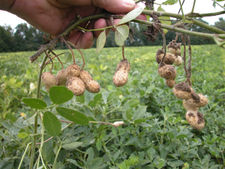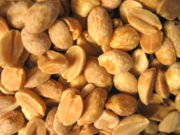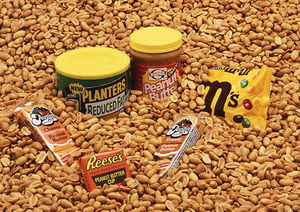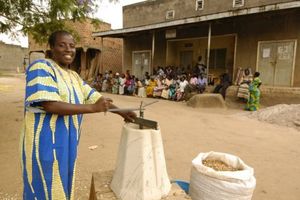Peanut
2007 Schools Wikipedia Selection. Related subjects: Food and agriculture; Plants
| iPeanut | ||||||||||||||||||
|---|---|---|---|---|---|---|---|---|---|---|---|---|---|---|---|---|---|---|
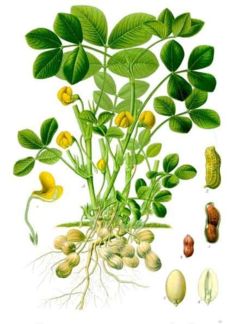 Peanut (Arachis hypogea)
|
||||||||||||||||||
| Scientific classification | ||||||||||||||||||
|
||||||||||||||||||
|
|
||||||||||||||||||
| Arachis hypogaea L. |
The peanut, or groundnut (Arachis hypogaea) is a species in the legume family Fabaceae native to South America. It is an annual herbaceous plant growing to 30 to 50 cm (1 to 1 1/2 feet) tall. The leaves are opposite, pinnate with four leaflets (two opposite pairs; no terminal leaflet), each leaflet 1 to 7 cm (1/3 to 2.75 inches) long and 1 to 3 cm (1/3 to 1 inch) broad. The flowers are a typical peaflower in shape, 2 to 4 cm (3/4 to one and a half inches) across, yellow with reddish veining. After pollination, the fruit develops into a legume 3 to 7 cm (1 to 2 inches) long containing 2 to 3 (rarely 1 or 4) seeds, which forces its way underground to mature.
Although a nut in the culinary sense, in the botanical sense the fruit of the peanut is a woody, indehiscent legume or pod and not technically a nut.
Peanuts are also known as earthnuts, goobers, goober peas, pindas, jack nuts, pinders, manila nuts and monkey nuts (the last of these is often used to mean the entire pod, not just the seeds).
Cultivation
Evidence demonstrates that peanuts were domesticated in prehistoric times in South America, where wild ancestors are still found. Cultivation spread as far as Mesoamerica where the Spanish conquistadors found the tlalcacahuatl ( Nahuatl="earth cacao"=peanut, whence Mexican Spanish, cacahuate) being offered for sale in the marketplace of Tenochtitlan (Mexico City), as they are still offered by street vendors there today. The plant was later spread worldwide by European traders. Cultivation in the English colonies of North America was popularized by African Americans, who brought the Kikongo word "goober".
In South America, the peanut (called there maní or amendoim in Brazil) is thought to have first grown in Argentina or Bolivia, where the most wild strains grow today.
The peanut gained Western popularity when it came to the United States from Africa. It had become popular in Africa after being brought there from Brazil by the Portuguese.
The flower of the Arachis hypogaea is borne above ground and after it withers, the stalk elongates, bends down, and forces the ovary underground. When the seed is mature, the inner lining of the pods (called the seed coat) changes colour from white to a reddish brown. The entire plant, including most of the roots, is removed from the soil during harvesting.
The pods begin in the orange veined, yellow petaled, pea-like flowers, which are borne in axillary clusters above ground. Following self-pollination (peanuts are complete inbreeders), the flowers fade. The stalks at the bases of the ovaries, called pegs, elongate rapidly, and turn downward to bury the fruits several inches in the ground to complete their development.
The pods act in nutrient absorption. The fruits have wrinkled shells that are constricted between the two to three seeds. The mature seeds resemble other legume seeds, such as beans, but they have paper-thin seed coats, as opposed to the usual, hard legume seed coats.
Peanuts grow best in light, sandy loam soil. They require five months of warm weather, and an annual rainfall of 500 to 1000 mm (20 to 40 in) or the equivalent in irrigation water.
The pods ripen 120 to 150 days after the seeds are planted. If the crop is harvested too early, the pods will be unripe. If they are harvested late, the pods will snap off at the stalk, and will remain in the soil.
Peanuts are particularly susceptible to contamination during growth and storage. Poor storage of peanuts can lead to an infection by the mold fungus Aspergillus flavus, releasing the toxic substance aflatoxin. The aflatoxin producing molds exist throughout the peanut growing areas and may produce aflatoxin in peanuts when conditions are favorable to fungal growth.
Cultivars
Thousands of peanut cultivars are grown, with four major Cultivar Groups being the most popular: Spanish, Runner, Virginia, and Valencia. There are also Tennessee Red and Tennessee White groups. Certain Cultivar Groups are preferred for particular uses because of differences in flavor, oil content, size, shape, and disease resistance. For many uses the different cultivars are interchangeable. Most peanuts marketed in the shell are of the Virginia type, along with some Valencias selected for large size and the attractive appearance of the shell. Spanish peanuts are used mostly for peanut candy, salted nuts, and peanut butter. Most Runners are used to make peanut butter.
The various types are distinguished by branching habit and branch length. There are numerous varieties of each type of peanut. There are two main growth forms, bunch and runner. Bunch types grow upright, while runner types grow near the ground.
Each year new cultivars of peanuts are bred and introduced somewhere in the peanut belt of the U.S. or in other countries. Introducing a new cultivar may mean change in the planting rate, adjusting the planter, harvester, dryer, cleaner, sheller, and method of marketing.
Spanish group
The small Spanish types are grown in South Africa, and in the southwestern and southeastern U.S. Prior to 1940, 90 % of the peanuts grown in Georgia were Spanish types, but the trend since then has been larger seeded, higher yielding, more disease resistant cultivars. Spanish peanuts have a higher oil content than other types of peanuts and in the U.S. are now primarily grown in Oklahoma and Texas.
Cultivars of the Spanish group include 'Dixie Spanish', 'Improved Spanish 2B', 'GFA Spanish', 'Argentine', 'Spantex', 'Spanette', 'Shaffers Spanish', 'Natal Common (Spanish)', 'White Kernel Varieties', 'Starr', 'Comet', 'Florispan', 'Spanhoma', 'Spancross', and 'Wilco I'.
Runner group
Since 1940, there has been a shift to production of Runner group peanuts in the southeastern U.S. Runners are found in Georgia, Alabama, Florida, and South Carolina. This shift is due to good flavor, better roasting characteristics and higher yields when compared to Spanish types leading to food manufacturers' preference for use in peanut butter and salting.
Cultivars of Runners include 'Southeastern Runner 56-15', 'Dixie Runner', 'Early Runner', 'Virginia Bunch 67', 'Bradford Runner', 'Egyptian Giant' (also known as 'Virginia Bunch' and 'Giant'), 'Rhodesian Spanish Bunch' (Valencia and Virginia Bunch), 'North Carolina Runner 56-15', 'Florunner', and 'Shulamit'.
Virginia group
The large seeded Virginia Group peanuts are grown in Virginia, North Carolina, Tennessee, and parts of Georgia. They are increasing in popularity due to demand for large peanuts for processing, particularly for salting, confections, and roasting in the shells.
Virginia Group peanuts are either bunch or running in growth habit. The bunch type is upright to spreading. It attains a height of 45 to 55 cm (18 to 22 inches), and a spread of 70 to 80 cm (28 to 30 in), with 80 to 90 cm (33 to 36 in) rows that seldom cover the ground. The pods are borne within 5 to 10 cm of the base of the plant.
Cultivars of Virginia type peanuts include NC 7, NC 9, NC 10C, NC-V 11, VA 93B, NC 12C, VA-C 92R, Gregory, VA 98R, Perry, Wilson, and Georgia Green.
Valencia group
Valencia Group peanuts are coarse, and they have heavy reddish stems and large foliage. In the U.S. they are primarily grown in Eastern New Mexico. They are comparatively tall, having a height of 125 cm (50 inches) and a spread of 75 cm (30 inches). Peanut pods are borne on pegs arising from the main stem and the side branches. Most of the pods are clustered around the base of the plant, and only a few are found several inches away. Valencia types are three seeded and smooth, with no constriction between the seeds. Seeds are oval and tightly crowded into the pods. There are two strains, one with flesh and the other with red seeds. Typical seed weight is 0.4 to 0.5 g.
Tennessee Red and Tennessee White groups
These are alike, except for the colour of the seed. The plants are similar to Valencia types, except that the stems are green to greenish brown, and the pods are rough, irregular, and have a smaller proportion of kernels.
Uses
Peanuts for edible uses account for two-thirds of the total peanut consumption in the United States. The principal uses are salted, shelled nuts, peanut butter (popular in sandwiches), peanut brittle, candy bars, and nuts that have been roasted in the shell. Salted peanuts are usually roasted in oil and packed in retail size, plastic bags or hermetically sealed cans. Dry roasted, salted peanuts are also marketed in significant quantities. The primary use of peanut butter is in the home, but large quantities are also used in the commercial manufacture of sandwiches, candy, and bakery products. Boiled peanuts are a preparation of raw, unshelled green peanuts boiled in brine and typically eaten as a snack in the southern United States where most peanuts are grown.
Peanut oil is often used in cooking, because it has a mild flavor and burns at a relatively high temperature. Under the name Plumpy'nut 100 g (3.5 ounces), two small bags per day are given by the World Health Organization as a surviving base to many children in Africa. Peanuts are often a major ingredient in mixed nuts because of their inexpensiveness compared to Brazil nuts, cashews, walnuts, and so on. The U.S. airline industry used to be a relatively large purchaser of peanuts for serving during flights (6 million pounds annually) before the nuts were removed from flights by many airlines (largely due to allergy concerns, but also due to cost).
Peanuts are also very widely sold for garden bird feeding. Low grade or culled peanuts not suitable for the edible market are used in the production of peanut oil, seed and feed, although some owners of pet hookbills avoid these kinds for that reason.
Peanuts have a variety of industrial end uses. Paint, varnish, lubricating oil, leather dressings, furniture polish, insecticides, and nitroglycerin are made from peanut oil. Soap is made from saponified oil, and many cosmetics contain peanut oil and its derivatives. The protein portion of the oil is used in the manufacture of some textile fibers.
Peanut shells are put to use in the manufacture of plastic, wallboard, abrasives, and fuel. They are also used to make cellulose (used in rayon and paper) and mucilage (glue).
Peanut plant tops are used to make hay. The protein cake (oilcake meal) residue from oil processing is used as an animal feed and as a soil fertilizer.
Allergies
Although many people enjoy foods made with peanuts, some people have severe allergic reactions. For people with peanut allergy, exposure can cause fatal anaphylactic shock. For these individuals, eating a single peanut or just breathing the dust from peanuts can cause a fatal reaction. An allergic reaction also can be triggered by eating foods that have been processed with machines that have previously processed peanuts, making avoiding such foods difficult.
A theory of the development of peanut allergy has to do with the way that peanuts are processed in North America versus other countries like China and India. Peanuts are widely eaten in China and India but peanut allergies are almost unheard of there. According to a 2003 study, roasting peanuts, as more commonly done in North America, causes the major peanut allergen Ara h2 to become a stronger inhibitor of the digestive enzyme trypsin, making it more resistant to digestion. Additionally, this allergen has also been shown to protect Ara h1, another major peanut allergen, from digestion - a characteristic further enhanced by roasting.
Though the allergy can last a lifetime, another 2003 study indicates that 23.3% of children will outgrow a peanut allergy.
Peanut allergy has been associated with the use of skin preparations containing peanut oil among children, but the evidence is not regarded as conclusive. Peanut allergies have also been associated with family history and intake of soy products.
Some school districts have banned peanuts, and there is now an experimental drug being tested to combat this allergy, called TNX-901.
As the peanut is a member of the legume family unrelated to other nuts, individuals with peanut allergies may not be allergic to the other types of nuts, and vice-versa.
U.S. Department of Agriculture program
George Washington Carver, an American agricultural researcher, is often credited with inventing 300 different uses for peanuts (which, contrary to popular belief, did not include peanut butter). Both the number of Carver's peanut products and their economic impact on the Southern United States economy have been greatly inflated. None of the products Carver originated was ever a commercial success. Carver was one of many USDA researchers who encouraged cotton farmers in the South to grow peanuts instead of, or in addition to cotton, because cotton had depleted so much nitrogen from the soil, and one of the peanut's properties as a legume is to put nitrogen back into the soil (a process known as nitrogen fixation). Rising demand for peanuts in the early 1900s was not due to Carver's products but to a shortage of plant oils due to World War I and the growing popularity of peanut butter, roasted peanuts and peanut candies. Peanut products originating in the early 1900s include many brands still sold today such as Planters peanuts (1906), Oh Henry! candy bar (1920), Baby Ruth candy bar (1920), Butterfinger candy bar (1923), Mr. Goodbar candy bar (1925), Reese's Peanut Butter Cup (1925), Peter Pan (peanut butter) (1928) and Skippy peanut butter (1932).
Peanuts were designated by the U.S. Congress to be one of America's basic crops. In order to protect domestic industry by keeping prices artificially high, the United States Department of Agriculture (USDA) conducts a Program for Peanuts. Two USDA programs for domestic peanuts are the Price Support Program and the Production Adjustment Program (National Poundage Quota). The Price Support Program consists of a two-tier price support system that is tied to a maximum weight quota. Domestic peanuts produced subject to the weight quota are supported at the higher of two prices, while peanuts over quota or those produced on farms not having a quota are supported at the lower rate. The quota support price acts as a floor price for domestic edible peanuts. For producers who fail to fill their quota in any given year, there is a maximum 10 % over marketing allowance for the subsequent year. Pursuant to the program, producers may place peanuts under nonrecourse loan with the Commodity Credit Corporation (CCC) at the designated support price or they may privately contract for the sale of their crop. It is also illegal under Federal Law to grow peanuts on more than one acre (4,000 m²) of land for commercial consumption. This effectively creates a peanut monopoly, as it is not economically feasible to grow peanuts on only one acre (4,000 m²) of land, while drastically increasing prices.
Cultivation in China
Although it has been suggested that a now unknown Old World species of peanut was cultivated in China from prehistoric times, the New World peanut seems to have been introduced there by Portuguese traders in the 1600s (University of Georgia 2006) and another variety by American missionaries in the 1800s. They became popular and are featured in many Chinese dishes, often being boiled. During the 1980s peanut production began to increase greatly so that today (2006) China is the world's largest peanut producer. A major factor in this increase has been China's move away from a communist economic system toward a more free market system so that farmers are free to grow and market their crops as they decide (Yao 2004).
The USDA reports:
- The Government of China does not control or intervene in peanut production or marketing. It does not provide subsidies, either direct or indirect. As an indication of the government’s lack of involvement in the peanut industry, China’s Ministry of Agriculture (MOA) did not even mention peanuts in its May 2003 report in which it outlined its strategic development plan for major crops. (Butterworth 2003)
Tanganyikan groundnut scheme
Peanuts were involved in the Tanganyika groundnut scheme, a widescale but unsuccessful effort by the British government to bring marginal lands into production in Tanganyika (now part of Tanzania). Among other reasons, the scheme was unsuccessful because the ground was clay-like and hardened after the end of the rainy season, making harvesting the peanuts impossible.
Trade
The major producers/exporters of peanuts are the United States, Argentina, Sudan, Senegal, and Brazil. These five countries account for 71 % of total world exports. In recent years, the United States has been the leading exporter of peanuts. The major peanut importers are the European Union (EU), Canada, and Japan. These three areas account for 78 % of the world's imports.
Although India and China are the world's largest producers of peanuts, they account for a small part of international trade because most of their production is consumed domestically as peanut oil. Exports of peanuts from India and China are equivalent to less than 4% of world trade.
Ninety percent of India's production is processed into peanut oil. Only a nominal amount of hand-picked select-grade peanuts are exported. India prohibits the importation of all oil seeds, including peanuts.
The European Union is the largest consuming region in the world that does not produce peanuts. All of its consumption is supplied by imports. Consumption of peanuts in the EU is primarily as food, mostly as roasted-in-shell peanuts and as shelled peanuts used in confectionery and bakery products.
The average annual U.S. imports of peanuts are less than 0.5 % of U.S. consumption. Two thirds of U.S. imports are roasted, unshelled peanuts. The major suppliers are Singapore, Taiwan, Malaysia, Hong Kong, Mainland China, and Canada. The principal suppliers of shelled peanut imports are Argentina and Canada. Most of Canada's peanut butter is processed from Chinese peanuts. Imports of peanut butter from Argentina are in the form of a paste and must be further processed in the U.S. Other minor suppliers of peanut butter include Malawi, China, India, and Singapore.
Approximately 50 % of all peanuts produced in the United States are grown within a 160 km (100 mile) radius of Dothan, Alabama. Dothan is home to the National Peanut Festival established in 1938 and held each fall to honour peanut growers and celebrate the harvest.
Full Belly Project
It is estimated that half-a-billion people on Earth rely on the peanut as their primary source of protein. Most of these people are small land-holding farmers in Africa, South America, and Southeast Asia. The main factor limiting their ability to increase their output has been that they lack the technological infrastructure to shell peanuts at a cost-efficient rate. The job is usually delegated to women and children, who shell only about 1.5 kg per hour. In 2005 an organization of former Peace Corps volunteers known as the Full Belly Project designed an inexpensive, hand-powered peanut sheller, known as the "Malian peanut sheller" that can shell peanuts at around 55 kg per hour. The designs for the machine are in the public domain, and the organization hopes to create more appropriate technology for sustainable development in the future. Other inventions presently in research and development include a corn cracker and a soymilk maker. The main designer of the Malian peanut sheller and other Full Belly Project inventions is author and film technician Jock Brandis.
Nutritional value
| Peanuts Nutritional value per 100 g |
||||||||||
|---|---|---|---|---|---|---|---|---|---|---|
| Energy 590 kcal 2450 kJ | ||||||||||
|
||||||||||
Peanuts are a rich source of proteins (roughly 30 grams per cup after roasting) and Monounsaturated fat. Recent research on peanuts and nuts in general has found anti-oxidants and other chemicals that may provide health benefits. Peanuts are a significant source of resveratrol, a chemical studied for potential anti-aging effects.
Because peanuts are considered an incomplete protein, containing relatively low amounts of the essential amino acids Lysine, Cystine, and Methionine, it is advised to be sure that a diet or meal with peanuts as a staple also include complementary foods such as dairy or whole grain.

